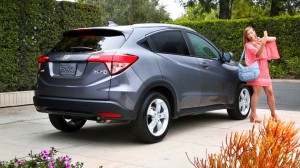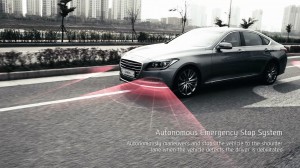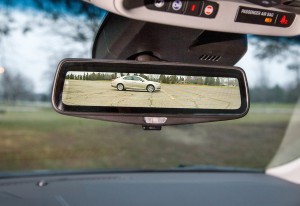
Honda's HR-V-SLF, also known as the "Selfie," was an April Fool's Day ruse, but makers are using cameras more often to improve vehicle safety.
It seems like a perfect fit for “selfie” fixated Millennials. Earlier this month, Honda announced plans for a special version of its new compact crossover-utility vehicle.
“Honda develops cutting-edge, selfie technology to engage younger buyers,” a news release blared. The Honda HR-V SLF, the Japanese maker explained, is “Equipped with 10 different ‘selfie’ cameras inside and outside the vehicle.”
Sadly for some potential buyers, the release was an April Fool’s Day joke. But in today’s world, one has to question whether there just might not be a market for the “selfie.” And there is some truth to the parody. While you likely won’t see a mobile selfie camera anytime soon, automakers are rapidly ramping up the number of cameras they use in today’s vehicles, largely for safety reasons.
At the New York International Auto Show last week, Jaguar revealed that it will put six cameras in its redesigned XF sport sedan. Among other things, this enables a driver to get a simulated, 360-degree birds-eye view of the vehicle’s surroundings when parking or backing out of a space.
“A number of Land Rover models (also) have multi cameras,” noted Stuart Schorr, spokesman for Jaguar Land Rover North America, adding that they “afford a variety of views including 360 degree.” Several of them, Schorr noted, are mounted low on the body of those big SUVs where they could be submerged when a vehicle fords water. “Technically they are waterproof so there is no reason they would not work underwater.”
Several automakers have begun to offer camera-based systems on their sports car models. That includes Chevrolet which last year launched the new Corvette Performance Data Recorder – which it likened to “having a 32 GB crew chief” onboard.
“The Performance Data Recorder combines the ability to record and share drive videos with the power of a professional-level motorsports telemetry system,” said Tadge Juechter, Corvette chief engineer.
The system not only records a video of your drive but also can pair it with a moving map of a track, adding data to show how well you’ve been performing.
But most of the new camera systems are intended to enhance vehicle safety, experts note.
Several manufacturers have introduced systems designed to detect when a driver is growing drowsy. Lexus uses a camera that can detect telltale signs of flagging alertness, when it does sounding an alert to pull over and rest – or at least grab a cup of coffee.
After an unexpected delay, federal regulators last year finally announced new rules that will require all new vehicles sold in the U.S. to be equipped with “rear-view visibility systems” by May 1, 2018. The backup camera rules will be phased in starting by May 1, 2016 – but industry observers note that the majority of vehicles now on the road today already offer the technology, either as standard gear or in optional form.
(Crash: automakers race to introduce low-cost, anti-crash technologies. For more, Click Here.)

Hyundai's Emergency Stop System utilizes several cameras to help bring the vehicle to a stop without the driver's input, if necessary.
Most of these systems currently display rear images on a vehicle’s center-mounted infotainment screen. On some models without such screens, automakers are using special rearview mirrors that hide a small video image in the left corner until the car is shifted into reverse.
Even mirrors are being transformed by video technology. Most automakers now offer blind-spot detection technologies that will flash a warning or sound an alert if a vehicle is hidden when a motorist signals to change lanes. Honda offers an alternative, the right turn signal activating a video camera that shows its image of the blind spot on the infotainment screen.
Cadillac, meanwhile, will introduce a new camera system on its CT6 flagship sedan that effectively replaces the standard rearview mirror. With a touch of a button, the windshield-mounted mirror’s video display takes over. It eliminates obstacles in the back seat, and eliminates blind spots created by pillars.
“The closest comparison to this kind of rear vision would be driving a convertible with the top down,” explains CT6 Chief Engineer Travis Hester.
(Click Here for details about six in 10 teen crashes due to distracted driving.)
Cameras seem to be pointing everywhere extra straight up. But most are looking in the same direction as the driver. In fact, Subaru uses two, one mounted on either side of the rearview mirror, to create a stereoscopic view of the world ahead. Dubbed Subaru Eyesight, the system can detect when your vehicle is closing too quickly on the car ahead, among other things, sounding an alert and, if necessary, even applying the brakes automatically.
Toyota recently announced several new, low-cost safety packages using both cameras and radar sensors to integrate a variety of different safety features, including forward collision warning and active cruise control, the latter able to hold a vehicle’s speed to that of the surrounding traffic flow.
The new Cadillac CT6 adds infrared Night Vision, a technology already available on the Mercedes-Benz S-Class. These systems not only can penetrate the dark but highlight pedestrians, animals and other obstacles.
(To see more about Delphi’s new automated driving system, Click Here.)
Like the new Jaguar XF, the 2016 Infiniti QX50 will feature six onboard cameras. But how many more might tomorrow’s cars use? Tesla is waiting to see if federal regulators will approve a request to eliminate outside mirrors and replace them with cameras on its Model X battery-electric sport-utility vehicle. It’s a concept found on countless concept cars shown as far back as the 1950s.
The potential is so great that chip and video car manufacturer NVDIA recently demonstrated a system that could handle as many as 12 cameras simultaneously. It’s anyone’s guess whether that will be enough to meet the needs of future, high-tech vehicles, especially when autonomous cars start coming to market in the decade ahead.


Selfies explain many of the problems in society…